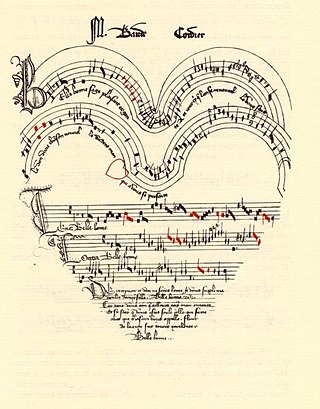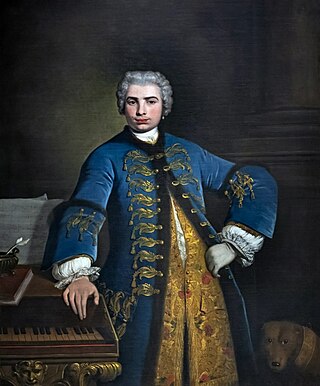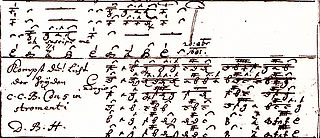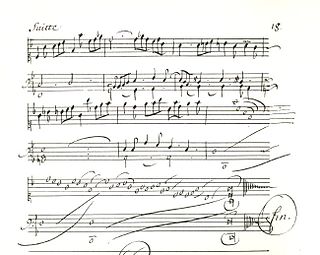
Gregorian chant is the central tradition of Western plainchant, a form of monophonic, unaccompanied sacred song in Latin of the Roman Catholic Church. Gregorian chant developed mainly in western and central Europe during the 9th and 10th centuries, with later additions and redactions. Although popular legend credits Pope Gregory I with inventing Gregorian chant, scholars believe that it arose from a later Carolingian synthesis of the Old Roman chant and Gallican chant.

Ars subtilior is a musical style characterized by rhythmic and notational complexity, centered on Paris, Avignon in southern France, and also in northern Spain at the end of the fourteenth century. The style also is found in the French Cypriot repertory. Often the term is used in contrast with ars nova, which applies to the musical style of the preceding period from about 1310 to about 1370; though some scholars prefer to consider ars subtilior a subcategory of the earlier style. Primary sources for ars subtilior are the Chantilly Codex, the Modena Codex, and the Turin Manuscript.

Coloratura is an elaborate melody with runs, trills, wide leaps, or similar virtuoso-like material, or a passage of such music. Operatic roles in which such music plays a prominent part, and singers of these roles, are also called coloratura. Its instrumental equivalent is ornamentation. Coloratura is particularly found in vocal music and especially in operatic singing of the 18th and 19th centuries.
Johann Jakob Froberger was a German Baroque composer, keyboard virtuoso, and organist. Among the most famous composers of the era, he was influential in developing the musical form of the suite of dances in his keyboard works. His harpsichord pieces are highly idiomatic and programmatic.

Johann Kuhnau was a German polymath, known primarily as a composer today. He was also active as a novelist, translator, lawyer, and music theorist, and was able to combine these activities with his duties in his official post as Thomaskantor in Leipzig, which he occupied for 21 years. Much of his music, including operas, masses, and other large-scale vocal works, is lost. His reputation today rests on his Biblical Sonatas, a set of programmatic keyboard sonatas published in 1700, in which each sonata depicted in detail a particular story from the Bible. After his death, Kuhnau was succeeded as Thomaskantor by Johann Sebastian Bach.

Mensural notation is the musical notation system used for polyphonic European vocal music from the late 13th century until the early 17th century. The term "mensural" refers to the ability of this system to describe precisely measured rhythmic durations in terms of numerical proportions amongst note values. Its modern name is derived from the terminology of medieval theorists, who used terms like musica mensurata or cantus mensurabilis to refer to the rhythmically defined polyphonic music of their age, as opposed to musica plana or musica choralis, i.e., Gregorian plainchant. Mensural notation was employed principally for compositions in the tradition of vocal polyphony, whereas plainchant retained its own, older system of neume notation throughout the period. Besides these, some solely instrumental music could be written in various forms of instrument-specific tablature notation.

Music manuscripts are handwritten sources of music. Generally speaking, they can be written on paper or parchment. If the manuscript contains the composer's handwriting it is called an autograph. Music manuscripts can contain musical notation as well as texts and images. There exists a wide variety of types from sketches and fragments, to compositional scores and presentation copies of musical works.

Keyboard tablature is a form of musical notation for keyboard instruments. Widely used in some parts of Europe from the 15th century, it co-existed with, and was eventually replaced by modern staff notation in the 18th century. The defining characteristic of the best known type, German organ tablature, is the use of letters to indicate pitch as well as beams for rhythm. Spain and Portugal used a slightly different cipher tablature, called cifra.
Armenian chant is the melismatic monophonic chant used in the liturgy of the Armenian Apostolic Church and the Armenian Catholic Church.

The Bauyn manuscript is a manuscript currently in possession of the Bibliothèque Nationale de France in Paris. It is, along with several printed collections and the Parville manuscript, one of the most important sources for French harpsichord music of the 17th century.
Willi Apel was a German-American musicologist and noted author of a number of books devoted to music. Among his most important publications are the 1944 edition of The Harvard Dictionary of Music and French Secular Music of the Late Fourteenth Century.
Old Roman chant is the liturgical plainchant repertory of the Roman rite of the early Christian Church. It was formerly performed in Rome, and, although it is closely related to Gregorian chant, the two are distinct. Unlike other chant traditions, Old Roman chant and Gregorian chant share essentially the same liturgy and the same texts. Many of their melodies are also closely related. Although primarily associated with the churches of Rome, the Old Roman chant was also performed in parts of central Italy, and it was possibly performed much more widely. Gregorian Chant gradually but completely supplanted Old Roman Chant between the 11th century and the 13th century AD.

The Répertoire International des Sources Musicales is an international non-profit organization, founded in Paris in 1952, with the aim of comprehensively documenting extant historical sources of music all over the world. It is the largest organization of its kind and the only entity operating globally to document written musical sources. RISM is one of the four bibliographic projects sponsored by the International Musicological Society and the International Association of Music Libraries, Archives and Documentation Centres, the others being Répertoire International de Littérature Musicale, Répertoire international d'iconographie musicale, and Répertoire international de la presse musicale.
Polish organ tablatures include some of the earliest and most important tablature sources of instrumental music in Europe. Particularly well-known is the Jan z Lublina tablature, which dates from mid-16th century and contains some 250 pieces. Most Polish organ tablatures use the German form of notation. The genres vary from all kinds of liturgical music to dances and vocal intabulations. This article presents a partial list of Polish organ tablatures, in chronological order.

Grimace was a French composer-poet in the ars nova style of late medieval music. Virtually nothing is known about Grimace's life other than speculative information based on the circumstances and content of his five surviving compositions of formes fixes; three ballades, a virelai and rondeau. His best known and most often performed work in modern-times is the virelai and proto-battaglia: A l’arme A l’arme.
Johann Krieger was a German composer and organist, younger brother of Johann Philipp Krieger. Born in Nuremberg, he worked at Bayreuth, Zeitz, and Greiz before settling in Zittau. He was one of the most important keyboard composers of his day, highly esteemed by, among others, George Frideric Handel. A prolific composer of church and secular music, he published several dozen of his works, and others survive in manuscript. However, hundreds more were lost when Zittau was destroyed by fire in 1757, during the Seven Years' War.
Chaconne in D minor is an organ chaconne by Johann Pachelbel. It is one of the six surviving chaconnes by the composer, and one of his best known organ works.
Jehan Vaillant was a French composer and music theorist. He is named immediately after Guillaume de Machaut by the Règles de la seconde rhétorique, which describes him as a "master … who had a school of music in Paris". Besides five pieces of music surviving to his name, he was also the author of a treatise on tuning. With Grimace and F. Andrieu and P. des Molins, Vaillant was part of the post-Machaut generation whose music shows few distinctly ars subtilior features, leading scholars to recognize Vaillant's work as closer to the ars nova style of Machaut.
The Modena Codex is an early fifteenth-century Italian manuscript of medieval music. The manuscript is one of the most important sources of the ars subtilior style of music. It is held in the Biblioteca Estense library in Modena.
P. des Molins, probably Pierre des Molins, was a French composer-poet in the ars nova style of late medieval music. His two surviving compositions – the ballade De ce que fol pensé and rondeau Amis, tout dous vis – were tremendously popular as they are among the most transmitted pieces of fourteenth-century music. The ballade is found in 12 medieval manuscript sources and featured in a c. 1420 tapestry; the rondeau is found in 8 sources and referenced by the Italian poet Simone de' Prodenzani. Along with Grimace, Jehan Vaillant and F. Andrieu, Molins was one of the post-Guillaume de Machaut generation whose music shows few distinctly ars subtilior features, leading scholars to recognize Molins's work as closer to the ars nova style of Machaut.










